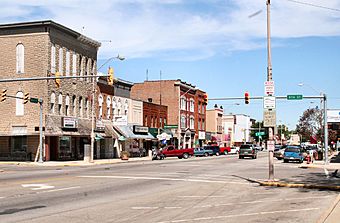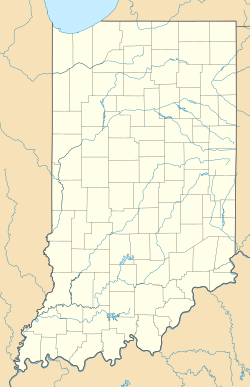Rochester Downtown Historic District facts for kids
Quick facts for kids |
|
|
Rochester Downtown Historic District
|
|

Intersection in the district
|
|
| Location | Roughly bounded along Main St. and the Courthouse Square, Rochester, Indiana |
|---|---|
| Architect | Rush, A.W. & Son; et al. |
| Architectural style | Late Victorian, Colonial Revival, Romanesque |
| NRHP reference No. | 08000556 |
| Added to NRHP | June 24, 2008 |
The Rochester Downtown Historic District is a special area in Rochester, Indiana, United States. It's like a protected neighborhood because its buildings are very old and important. This district was added to the National Register of Historic Places (NRHP) on June 24, 2008. Most buildings here are made of strong materials like brick and stone. Many show a style called Italianate, which was popular a long time ago. Buildings outside this area are mostly homes made of wood.
Contents
Exploring Rochester's Historic Downtown
Rochester started as a trading post in 1831. This was a place where European settlers and local Native Americans traded goods. It was built where the old Michigan Road crossed Mill Creek. Many of the important old buildings you see today are along this same Michigan Road, which is now called Main Street.
How Rochester Grew Over Time
In 1835, Alexander Chamberlain built the first hotel in Rochester. He also helped plan the town that same year. In 1836, more land was added to the town plan. This new area included what is now the courthouse square. The first courthouse was made of wood and built in 1837. A jail was also built around that time. Rochester kept growing because it was located on the busy Michigan Road. By 1840, the town had 300 people and several tall buildings.
The current courthouse was built much later, between 1895 and 1896. The old jail was replaced in 1851. When the Indianapolis, Peru and Chicago Railroad arrived in 1869, building with brick became very common for shops and businesses.
Important Buildings to See
Many buildings in the district are very special. The Fulton County Courthouse is one of them. It's a grand building with a unique style called Richardsonian Romanesque. This courthouse is so important that it's also listed on the National Register of Historic Places by itself.
Other key buildings include a tall water tower, the Rochester City Hall and Fire Department, the post office, and the telephone company. The courthouse is made of limestone and has been on the National Register since 2000. On its grounds, you can find four different memorials. These include one for the Potawatomi people's Trail of Death. There is also a cornerstone for Rochester College and two memorials for wars.
Most buildings in the district are made of brick. However, after the courthouse was built with its rough limestone, some other buildings were updated. They had fake stone added to their brick walls to look similar to the courthouse. The Masonic Temple is an example of this. You can also see limestone used for name blocks on buildings. The historic fire department has its name carved in limestone above its door. The city hall also has a similar limestone name block. It even has limestone diamond shapes above its windows.
Notable Buildings in the District
Here are some of the interesting buildings you can find in the Rochester Downtown Historic District. Each one helps tell the story of the town's past.
East Eight Street Buildings
- 118-22 – Centennial Block, Italianate, 1876
This building was built in 1876, the same year the United States celebrated its 100th birthday. It was first home to a clothing store. The Rochester Sentinel newspaper also operated from this building until 1924. The Sentinel is the oldest business still running in the county.
Main Street Buildings
- 714-12 – Dillon Building, Neo-Classical, around 1915
This building shows the Neo-Classical style, which uses ideas from ancient Greek and Roman buildings.
- 730-28 – Mammoth Building, Italianate, 1869
William Ritters built this large building in 1869. It was used by the Masons, a well-known community group.
- 800 – J.Dawson Building, Italianate, 1872
This building is another example of the Italianate style, which was very popular in the late 1800s.
- 800 block – Fulton County Courthouse, Richardsonian Romanesque, 1896
This grand courthouse was designed by A.W. Rush & Son and built in 1896. It stands out with its unique Richardsonian Romanesque style.
- 802 – Rochester Bank Building, Italianate, 1887
This building, constructed in 1887, also features the Italianate architectural style.
- 830-28 – I.O.O.F. Block, 1870
This building belonged to the International Order of Odd Fellows, another community organization.
- 831 – Historical Marker, Commemorates Founding of Rochester College, 1895
This marker tells the story of Rochester College. In 1893, local business people and educators thought Rochester was a great place for a college. The cornerstone for the college building was laid in June 1895. The building was made of brick and stone and could hold 400 students. The college closed in 1912 due to money problems.
Images for kids






